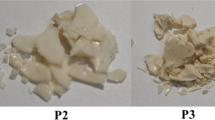Abstract
N,N′-Bis[2-(methyl-3-(4-hydroxyphenyl)propanoate)]isophthaldiamide (5), a novel diol monomer containing chiral group, was prepared by the reaction of S-tyrosine methyl ester (3) with isophthaloyl dichloride (4a). A new family of optically active and potentially biodegradable poly(ester-amide)s (PEAs) based on tyrosine amino acid were prepared by the polycondensation reaction of diol monomer 5 with several aromatic diacid chlorides. The resulting new polymers were obtained in good yields with inherent viscosities ranging between 0.25 and 0.42 dL/g and are soluble in polar aprotic solvents. They showed good thermal stability and high optical purity. The synthetic compounds were characterized and studied by FT-IR, 1H-NMR, specific rotation, elemental and thermogravimetric analysis (TGA) techniques and typical ones by 13C-NMR, differential scanning calorimetry (DSC), X-ray diffraction (XRD), and field emission scanning electron microscopy (FE-SEM) analysis. Soil burial test of the diphenolic monomer 5, and obtained PEA6a, and soil enzymatic assay showed that the synthesized diol and its polymer are biologically active and probably biodegradable in soil environment.













Similar content being viewed by others
References
Abdolmaleki A (2000) Synthesis and characterization of some new polyhydrazides. Shiraz University, Shiraz
Armelin E, Paracuellos N, Rodriguez-Galan A, Puiggali J (2001) Study on the degradability poly(ester amide)s derived from a-amino acids glycine, and l-alanine containing a variable amide/ester ratio. Polymer 42:7923–7932
Banihashemi A, Firoozifar H (2003) Synthesis and characterization of novel aromatic polyamides derived from two heterocyclic diamines. Eur Polym J 39:281–289
Bongaerts J, Krämer M, Müller U, Raeven L, Wubbolts M (2001) Metabolic engineering for microbial production of aromatic amino acids and derived compounds. Metab Eng 3:289–300
Dardas D, Kuczynski W (2004) Non-linear electrooptical effects in chiral liquid crystals. Opto-Electron Rev 12(3):277–280
Guo K, Chu C-C (2007) Biodegradation of unsaturated poly(ester-amide)s and their hydrogels. Biomaterials 28:3284–3294
Hu Q-S, Sun C, Monaghan CE (2001) Synthesis of optically active polymers with chiral units attached to rigid backbones and their application for asymmetric catalysis. Tetrahedron Lett 42(44):7725–7728
Li L, Seino H, Yonetake K, Ueda M (1999) Synthesis and characterization of ordered poly(amide-ester)s from isophthaloyl chloride and 4-(2-aminoethyl)phenol. Macromolecules 32(12):3851–3858
Liaw DJ, Liaw BY, Yang CM (2001) Synthesis and characterization of new soluble cardo aromatic polyamides bearing diphenylmethylene linkage and norbornyl group. Macromol Chem Phys 202:1866–1872
Mallakpour S, Kolahdoozan M (2007) Synthesis and properties of thermally stable and optically active novel wholly aromatic polyesters containing a chiral pendent group. Eur Polym J 43(8):3344–3354
Mallakpour S, Taghavi M (2009) Direct polyamidation in green media: Studies on thermal degradation of novel organosoluble and optically active flame retardant polyamides. React Funct Polym 69(3):206–215
Mallakpour S, Zadehnazari A (2009) Fast synthesis, using microwave induction heating in ionic liquid and characterization of optically active aromatic polyamides. J Macromol Sci Pure Appl Chem 46(8):783–789
Mallakpour S, Khani M, Rafiemanzelat F (2008) Synthesis and characterization of new optically active segmented poly(amide imide urethane)s based on different diacids via an isocyanate route. J Appl Polym Sci 108(5):2975–2982
Mallakpour S, Asadi P, Sabzalian MR (2010a) Synthesis of biodegradable chiral poly(ester-imide)s derived from valine-, leucine- and tyrosine-containing monomers. Amino Acids. doi:10.1007/s00726-010-0799-5
Mallakpour S, Tirgir F, Sabzalian MR (2010b) Novel biobased polyurethanes synthesized from nontoxic phenolic diol containing l-tyrosine moiety under green media. J Polym Environ. doi:10.1007/s10924-010-0234-8
Mallakpour S, Tirgir F, Sabzalian MR (2010c) Synthesis and structural characterization of novel biologically active and thermally stable poly(ester-imide)s containing different natural amino acids linkages. J Polym Res. doi:10.1007/s10965-010-9427-z
Mallakpour S, Tirgir F, Sabzalian MR (2011) Synthesis, characterization and in vitro antimicrobial and biodegradability study of pseudo-poly(amino acid)s derived from N,N′-(pyromellitoyl)-bis-l-tyrosine dimethyl ester as a chiral bioactive diphenolic monomer. Amino Acids 40:611–621
Mehdipour-Ataei S, Babanzadeh S (2007) Synthesis, characterization and properties of novel polyamides containing ferrocene unit and flexible spacers. Appl Organometal Chem 21:360–367
Nagai A, Ishikawa J, Kudo H, Endo T (2004) Synthesis of optically active polyurethanes by self-polyaddition of tyrosine-based monomers. J Polym Sci A Polym Chem 42(5):1143–1153. doi:10.1002/pola.11047
Okada M (2002) Chemical syntheses of biodegradable polymers. Prog Polym Sci 27:87–133
Okamoto Y, Ikai T (2008) Chiral HPLC for efficient resolution of enantiomers. Chem Soc Rev 37(12):2593–2608
Okamoto Y, Yashima E (1998) Polysaccharide derivatives for chromatographic separation of enantiomers. Angew Chem Int Ed 37(8):1021–1043
Pu L (1998) 1,1′-Binaphthyl dimers, oligomers, and polymers: molecular recognition, asymmetric catalysis, and new materials. Chem Rev 98(7):2405–2494
Sanda F, Endo T (1999) Syntheses and functions of polymers based on amino acids. Macromol Chem Phys 200(12):2651–2661
San-Jose N, Gomez-Valdemoro A, Garcia FC, Serna F, Garcia JM (2007) Aromatic polyamides with pendant urea moieties. J Polym Sci A Polym Chem 45:4026–4036
Sheng S-R, Pei X-L, Huang Z-Z, Liu X-L, Song C-S (2009) Novel soluble fluorinated aromatic polyamides derived from 2-(4-trifluoromethylphenoxy)terephthaloyl chloride with various aromatic diamines. Eur Polym J 45:230–236
Tamami B, Yeganeh H, Kohmareh GA (2004) Synthesis and characterization of novel polyesters derived from 4-aryl-2, 6-bis(4-chlorocarbonyl phenyl) pyridines and various aromatic diols. Eur Polym J 40:1651–1657
Tsai C-J, Chang W-C, Chen C-H, Lu H-Y, Chen M (2008) Synthesis and characterization of polyesters derived from succinic acid, ethylene glycol and 1,3-propanediol. Eur Polym J 44:2339–2347
Wang L, Wang Y, Cao D (2009) Synthesis and characterization of novel biodegradable polyamides containing α-amino acid. J Macromol Sci Pure Appl Chem 46(3):312–320
Acknowledgments
We wish to express our gratitude to the Research Affairs Division, Isfahan University of Technology (IUT) for financial support. Further financial support from National Elite Foundation (NEF), Iran Nanotechnology Initiative Council (INIC), and Center of Excellency in Sensors and Green Chemistry Research (IUT) is gratefully acknowledged.
Author information
Authors and Affiliations
Corresponding authors
Rights and permissions
About this article
Cite this article
Abdolmaleki, A., Mallakpour, S., Borandeh, S. et al. Fabrication of biodegradable poly(ester-amide)s based on tyrosine natural amino acid. Amino Acids 42, 1997–2007 (2012). https://doi.org/10.1007/s00726-011-0931-1
Received:
Accepted:
Published:
Issue Date:
DOI: https://doi.org/10.1007/s00726-011-0931-1




